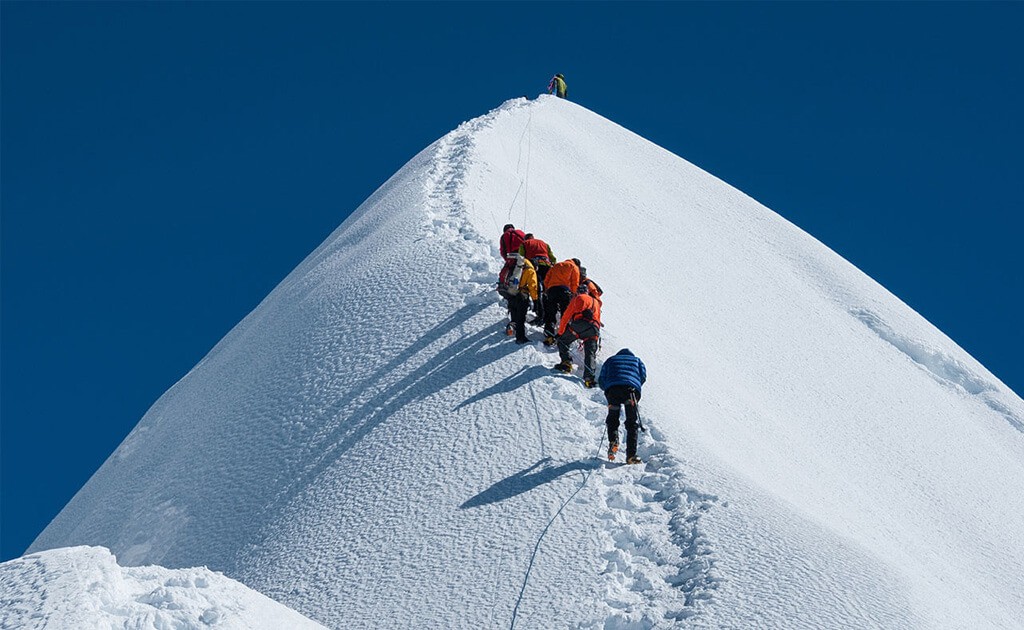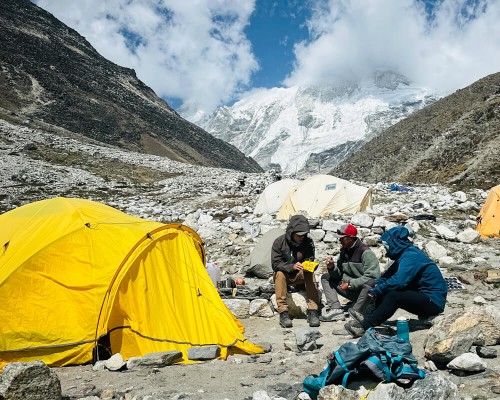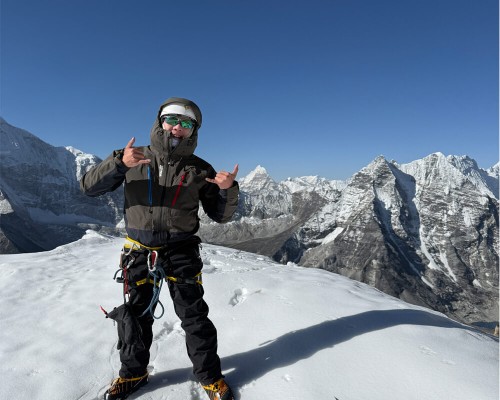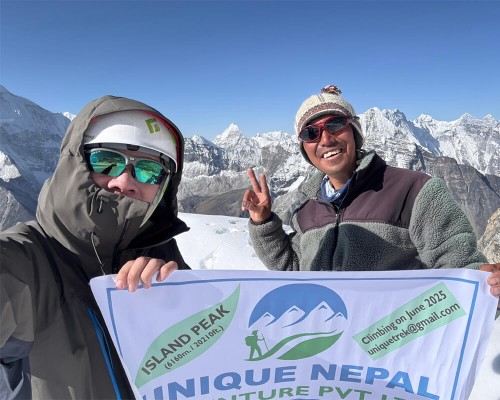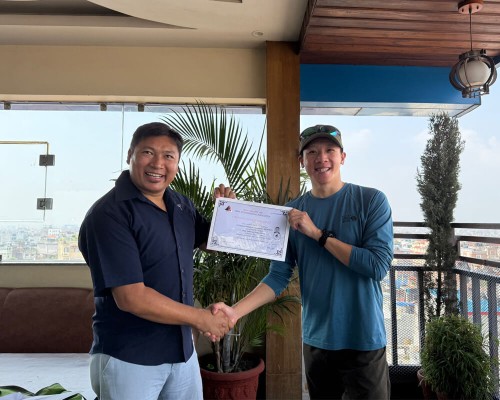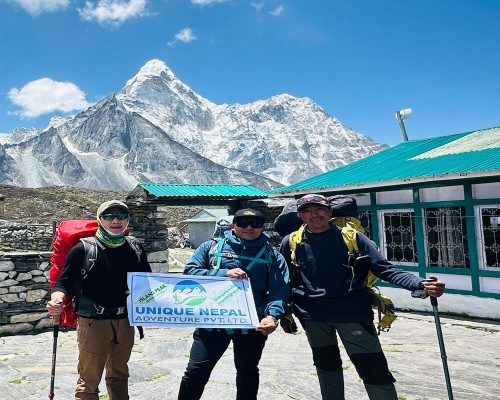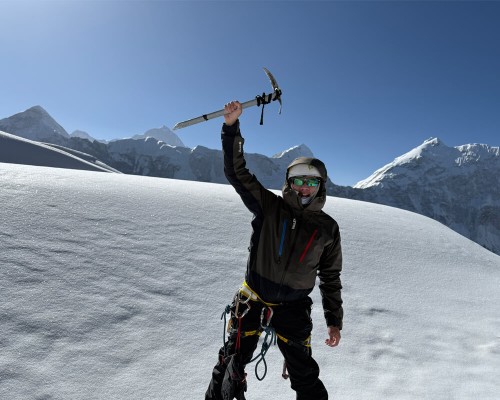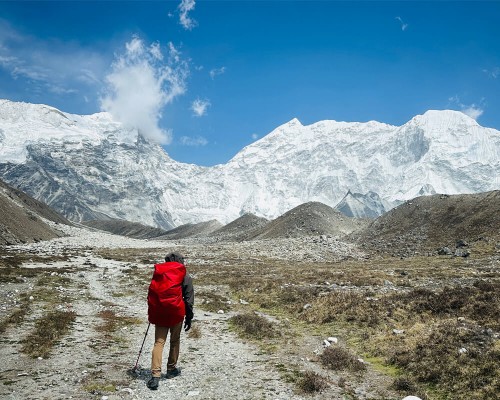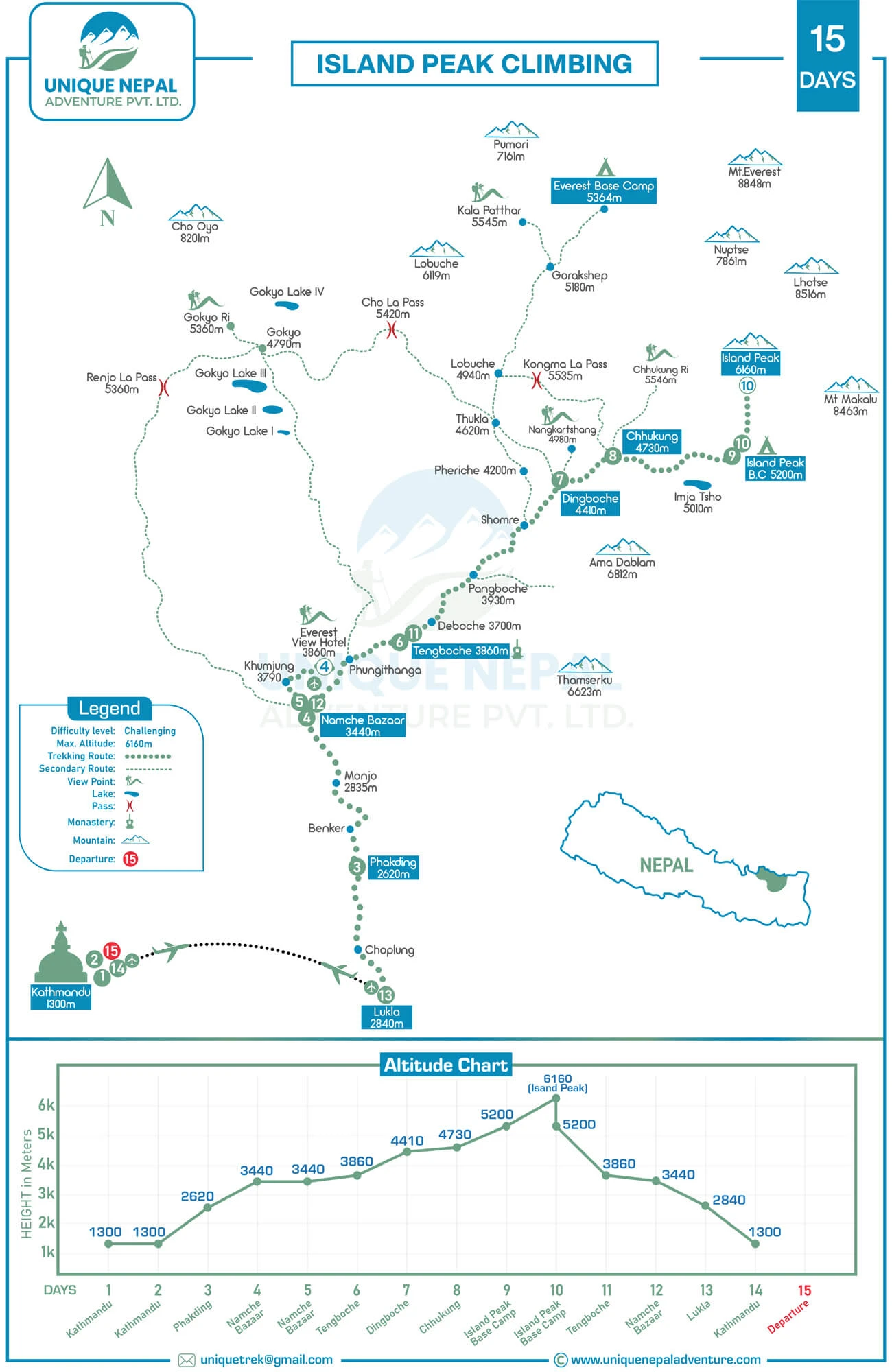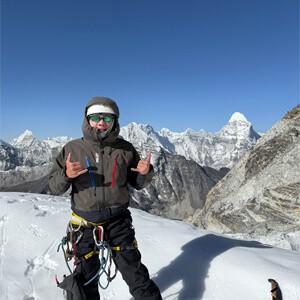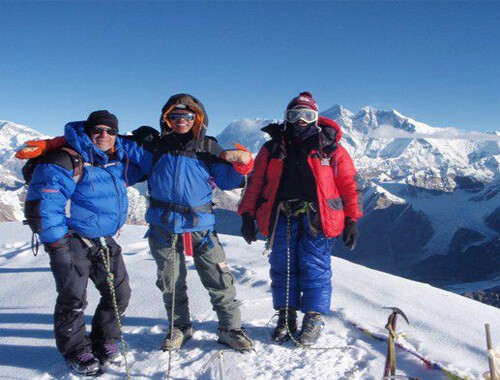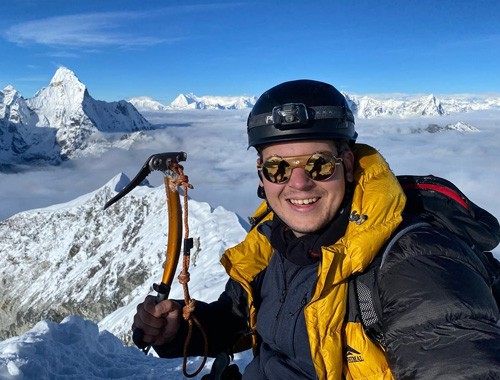Details Information About Island Peak Climbing (Imja Tse Peak)
Standing tall at 6,160 meters (20,210 ft) above sea level, Island Peak, also known by its local name Imja Tse, is a renowned climbing destination nestled in the heart of the Everest region of Nepal.
It is a distinctive appearance, a singular peak surrounded by a sea of glacial ice, inspired the name "Island Peak" when it was first identified by mountaineer Eric Shipton in 1952. While often considered a training ground for aspiring climbers aiming for the 8,000-meter giants.
Imja Tse presents a challenging and exhilarating climb in its own right. Situated between the monumental peaks of Mount Everest (8,848 m), Lhotse (8,516 m), and the stunning Ama Dablam (6,812 m).
Island Peak offers a unique blend of high-altitude trekking and technical mountaineering, culminating in an awe-inspiring panorama of some of the world's highest mountains. This expedition is not just about conquering a summit; it's about experiencing the breathtaking beauty of the Himalayas, immersing oneself in the vibrant Sherpa culture, and pushing the boundaries of personal endurance.
The Sherpa Lifestyle: A Culture Forged by Mountains
The journey to Island Peak is more than a physical trek; it's an opportunity to delve into the rich and fascinating culture of the Sherpa people. Known globally for their incredible strength, resilience, and profound mountaineering skills.
The Sherpas are the indigenous inhabitants of the Everest region. Their heritage is deeply intertwined with the mountains they call home, which they revere as sacred abodes of gods and goddesses.
As you trek through villages like Lukla, Phadking, Namche Bazaar, Pangboche, and Dingboche, you will witness the unique Sherpa way of life. Their homes are built to withstand the harsh Himalayan climate.
They are spiritually Buddhist, and there are so many monasteries, such as the famous one in Tengboche, that are centers of their spiritual world. Tibetan Buddhism heavily influences Sherpa culture, and you'll see this reflected in the prayer flags fluttering in the wind, the spinning of prayer wheels, and the serene, welcoming nature of the people.
Sherpas are kind, honest, and warm in their hospitality. They welcome with smiling faces. They celebrate a lot of festivals according to their culture. Definitely you will have an amazing experience.
They are farmers, and they have nice terraces. They have lots of yaks and jyopcho. They produce lots of vegetables, wheat, barley, and yak cheese.
Preparing Your Gear: Essential Equipment for a Successful Summit
Island Peak is a technical climb, requiring a comprehensive set of climbing gear to ensure safety and success. While the trekking portion to the base camp can be managed with standard hiking equipment, the final ascent demands specialized mountaineering gear. A professional, expert, and well-trained climbing guide is not only a crucial element of the team but is also a mandatory requirement for a legal and safe climb. They will provide guidance and training on the proper use of all equipment.
Essential climbing gear includes:
- Mountaineering Boots: Insulated, rigid-soled boots are essential for use with crampons. It's crucial to break them in before the trip to avoid blisters.
- Crampons: These metal frames with spikes attach to your boots, providing traction on the glacier and ice.
- Ice Axe: Used for self-arrest in case of a fall and for navigating icy slopes.
- Harness: A safety harness is worn to attach to the climbing ropes.
- Ascender (Jumar) and Descender (Figure 8): These devices are used for ascending and descending fixed ropes on steep sections of the climb.
- Helmet: A helmet is vital to protect against falling ice or rock.
- High-Altitude Clothing: This includes a high-quality down jacket, insulated pants, waterproof shells, and multiple layers to manage body temperature in extreme cold.
- Other Essentials: A headlamp with extra batteries, high-quality sunglasses with UV protection, and a durable backpack are also indispensable.
Proper preparation of your climbing gear is not merely a logistical step; it is a critical factor in mitigating the inherent risks of high-altitude mountaineering.
Best Time to Climb Island Peak: Navigating the Seasons
Choosing the right time to climb Island Peak is paramount to a successful and enjoyable expedition. The peak climbing seasons in Nepal are dictated by the monsoon and winter weather patterns.
Spring (March to May): This is widely regarded as the most popular and favorable season for climbing. The weather is generally stable, with clear skies and moderate temperatures, offering excellent visibility of the surrounding peaks. The trails are filled with blooming rhododendrons, creating a vibrant landscape. However, this is also the busiest time, so trails and lodges can be crowded, and permits should be secured well in advance.
Autumn (September to November): Following the monsoon season, autumn brings clear, crisp air and stunning views. The humidity is low, and the weather is stable, making for ideal trekking and climbing conditions. While temperatures begin to drop, especially at higher altitudes, this season offers a slightly less crowded experience than spring.
While it is possible to climb in winter (December to February), the extreme cold and heavy snowfall make it a more challenging and riskier endeavor. The monsoon season (June to August) is not recommended due to heavy rainfall, cloud cover, and slippery trails, which can lead to avalanches and poor visibility.
The Cost of Island Peak Climbing
A 15-day Island Peak climb costs $2050 per person, which is a full board package from arrival to departure. And, we customize the trip itinerary to visit Everest Base Camp and climb the peak; we need to extend a few extra days, and the cost would be a bit more. If you are climbing single, the cost would be slightly more; feel free.
Key components that make up the total cost include:
Permits: A special climbing permit from the Nepal Mountaineering Association (NMA) is required, and the cost varies by season. You will also need a Sagarmatha National Park entry permit and a local area permit.
Guide and Porter Fees: A licensed climbing guide is mandatory. Their fees, along with those for porters who carry your gear, are a significant part of the overall cost.
Accommodation and Food: The cost covers teahouse accommodations during the trekking portion and camping facilities at the base camp and high camp. Food is a major part of the package, with prices increasing as you ascend.
Transportation: This includes the domestic flights to and from Lukla from Kathmandu or Manthali, as well as airport transfers.
Equipment Rental: For those who don't own their own gear, renting climbing equipment adds to the total cost.
Booking with a reputable trekking company that organizes all the logistics is often the most secure and convenient option, ensuring you have the necessary permits, experienced guides, and proper equipment for a safe and successful climb.
The Views of the Himalayas: A Lifetime Memory
From the summit of Island Peak itself, the views are simply unparalleled. You will be standing in a circle of giants: the majestic Lhotse (8,516 m), a close neighbor that dominates the view; Makalu (8,463 m), a pyramid of rock and ice; and of course, the world’s highest peak, Mount Everest (8,848 m), seemingly within arm's reach. This is a moment of profound achievement and awe, a memory etched in your heart forever.
- Mt. Everest 8848m / 29029ft
- Mt. Lhotse 8516m / 27940ft
- Mt. Makalu 8463 m / 27766 ft.
- Mt. Amadablam 6812 m / 22350 ft.
- Peak 38: 7590m / 24902ft
- Mt. Pumori 7161m / 23495ft
- Mt. Nupse 7861m / 25791ft
- Mt Thamserku 6608m / 21680ft
- Island Peak 6160m / 20210ft
- Taboche Peak 6495m / 21310ft
- Lobuche Peak 6119m / 20076ft
The Route to the Summit: An Epic Itinerary
The journey to Island Peak follows the legendary Everest Base Camp Trekking route for a significant portion of the trip, providing a vital period for acclimatization. A typical itinerary is around 15 to 18 days, with the climbing days being the most demanding. We have a 15-day perfect itinerary. If you wish to visit EBC plus Island Peak, let me know, and I will create a perfect 18-day program.
The Trekking Phase: The adventure begins with a thrilling flight to Lukla, the gateway to the Everest region. The trek then progresses through beautiful Sherpa villages like Phakding and the vibrant Namche Bazaar. Days are spent hiking for 6-7 hours, with a gradual ascent of 500-700 meters to allow the body to adjust to the increasing altitude.
Acclimatization: Proper acclimatization is crucial for success and safety. The standard route often includes acclimatization days in Namche Bazaar and Dingboche, where climbers can take short hikes to higher elevations and return to a lower altitude to sleep. This "climb high, sleep low" strategy is key to preventing altitude sickness.
The Climb: From the village of Chhukung, the trail leads to the Island Peak Base Camp. Here, climbers will receive a crucial day of technical training from their professional climbing guide, practicing the use of fixed ropes, ascenders, and crampons in a designated training area.
Summit Push: The summit day is a long, arduous affair, typically starting in the early hours of the morning. The route involves navigating the glacier, a challenging headwall, and a final, thrilling ascent along a narrow ridge to the summit. A successful summit push is rewarded with an unparalleled 360-degree view of the Khumbu giants.
Camping in the Base Camp: The itinerary includes a special two-night, fully equipped camping experience at the Island Peak Base Camp. This provides a truly immersive mountaineering experience. All necessary camping gear, from tents to cooking equipment, is provided, ensuring you are comfortable and well-fed at the foot of the magnificent peak.
In conclusion, an Island Peak climb is a journey of a lifetime. It is a thrilling blend of cultural immersion, physical challenge, and unparalleled natural beauty. It's a testament to the fact that with proper preparation, an experienced team, and a resilient spirit, you can make your adventurous dreams come true.

